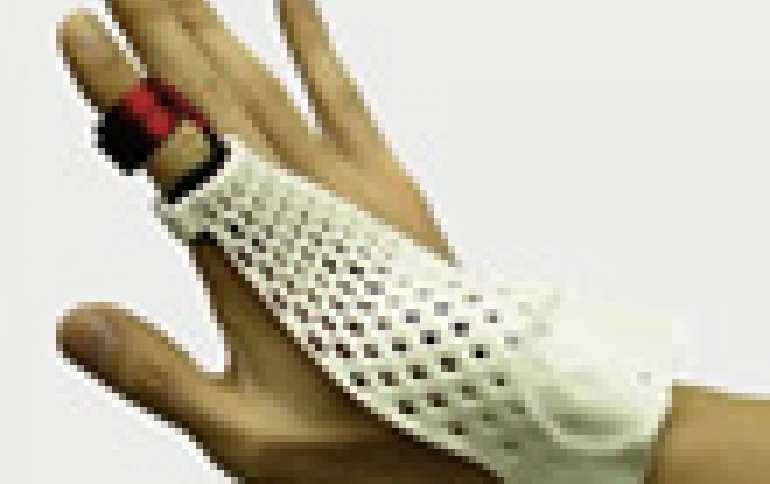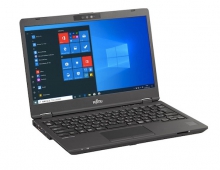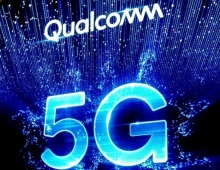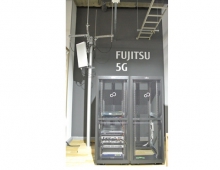
Fujitsu Develops Glove-Style Wearable Device
Fujitsu Laboratories has developed a wearable device in the form of a glove, which features gesture-based input for maintenance and other on-site operations along with a Near Field Communication (NFC) tag reader.
Existing field-support technologies require the operator to manipulate a smart device to get information. Some work settings, however, are not amenable to the use of such devices as they involve the wearing of gloves or working with dirty hands, making it difficult to retrieve and use a conventional smart device.
 Using this device lets the operator simply touch the NFC tag of the object being worked on to display relevant information. A gyro sensor and accelerometer in the wrist enable the device to recognize gestures.
Using this device lets the operator simply touch the NFC tag of the object being worked on to display relevant information. A gyro sensor and accelerometer in the wrist enable the device to recognize gestures.
Fujitsu has developed gesture-recognition technology that functions reliably in multiple tasks and postures without being awkward. Gesture-recognition accuracy is largely dependent on the ability to distinguish between gestures and normal arm movements during the course of work as well as variations in gestures between individuals. This recognition technology takes note when the wrist is in a dorsiflexed position, where the hand rotates back, a movement that is not common in everyday tasks, and activates on that position, so that it can distinguish between normal arm movements and gestures. It also defines gestures based on the shoulder as the center of a coordinate system.
Fujitsu's in-house testing showed that six patterns (up, down, left, right, rotate left, rotate right) could be recognized with 98% recognition accuracy. These gestures could be used to flip through pages of a manual being shown on a head-mounted display with left and right motions, or to scroll with up and down motions. In a scenario where it is used to input work status, a right rotation could indicate a normal state, and a left rotation a problem.
By equipping the operator's finger with a touch sensor and activating the NFC tag reader only for the moment the object is touched, power consumption is able to be kept low. This gives the glove device nine hours of runtime, compared to three hours for a device that lacks this kind of power control for operating time.
With the new wearable device, users can receive work instructions and other information, just by taking the natural action of touching an object. Task results can also be input using gestures so that operations can be carried out smoothly.
One example of a solution obtained by using the device together with a head-mounted display is when an operator touches a connector or control panel's NFC tag to obtain its work order, then making a simple gesture to register the task's results. This is expected to streamline operations and cut errors.
This glove device will be exhibited at Mobile World Congress 2014, running February 24-27 in Barcelona.
Fujitsu plans to perform verification testing on the technology with the aim of bringing a product to market in fiscal 2015.
 Using this device lets the operator simply touch the NFC tag of the object being worked on to display relevant information. A gyro sensor and accelerometer in the wrist enable the device to recognize gestures.
Using this device lets the operator simply touch the NFC tag of the object being worked on to display relevant information. A gyro sensor and accelerometer in the wrist enable the device to recognize gestures.
Fujitsu has developed gesture-recognition technology that functions reliably in multiple tasks and postures without being awkward. Gesture-recognition accuracy is largely dependent on the ability to distinguish between gestures and normal arm movements during the course of work as well as variations in gestures between individuals. This recognition technology takes note when the wrist is in a dorsiflexed position, where the hand rotates back, a movement that is not common in everyday tasks, and activates on that position, so that it can distinguish between normal arm movements and gestures. It also defines gestures based on the shoulder as the center of a coordinate system.
Fujitsu's in-house testing showed that six patterns (up, down, left, right, rotate left, rotate right) could be recognized with 98% recognition accuracy. These gestures could be used to flip through pages of a manual being shown on a head-mounted display with left and right motions, or to scroll with up and down motions. In a scenario where it is used to input work status, a right rotation could indicate a normal state, and a left rotation a problem.
By equipping the operator's finger with a touch sensor and activating the NFC tag reader only for the moment the object is touched, power consumption is able to be kept low. This gives the glove device nine hours of runtime, compared to three hours for a device that lacks this kind of power control for operating time.
With the new wearable device, users can receive work instructions and other information, just by taking the natural action of touching an object. Task results can also be input using gestures so that operations can be carried out smoothly.
One example of a solution obtained by using the device together with a head-mounted display is when an operator touches a connector or control panel's NFC tag to obtain its work order, then making a simple gesture to register the task's results. This is expected to streamline operations and cut errors.
This glove device will be exhibited at Mobile World Congress 2014, running February 24-27 in Barcelona.
Fujitsu plans to perform verification testing on the technology with the aim of bringing a product to market in fiscal 2015.





















